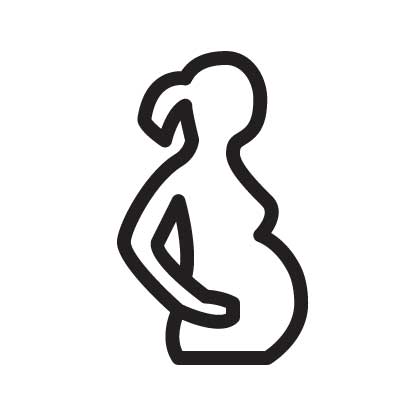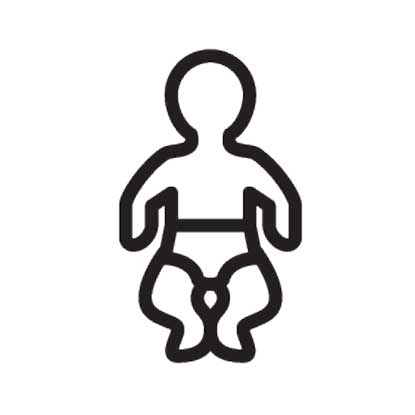Miscarriage
The first months of the pregnancy are a critical period. The embryo develops and settles into the wall of the uterus. Sadly, this doesn’t always happen the way it should. In that case, the result is a miscarriage.
A miscarriage is the loss of a non-viable embryo in the first period of the pregnancy. The embryo can die due to several reasons and subsequently be expelled. This happens more often than you might think: 15 to 20% of all diagnosed pregnancies end in a miscarriage.
In case of a very early miscarriage, growth has been stopped early on in the pregnancy, an embryo never developed. On the ultrasound we will only see an empty amniotic sac. If the miscarriage occurs at a later stage, in which the embryo has grown, we will see an embryo without a heartbeat.

Miscarriage
Causes
In 95% of all cases miscarriage is the result of preexisting condition of the embryo. Often this is the result of a chromosome disorder caused during conception. Nature looks for a “ solution” and the pregnancy ends in a miscarriage.
Usually, this is not the result of a hereditary condition. Hence, there is no increased risk for a subsequent pregnancy. In 5% of the cases the miscarriage is the result of an improper nidation, infection, aberrant shape of the uterus, a myoma or unknown cause. When a woman has had two or more miscarriages it is possible to have further examination done.
You cannot cause a miscarriage yourself. A miscarriage is not the result of physical exertion, making love, falling or, for example, horseback riding. It can, however, be the trigger for an already existing miscarriage, to start.
A miscarriage can’t be stopped or prevented.
Symptoms
One of the first signs of a miscarriage is usually loss of blood from the vagina. Pregnancy signs such as tender breasts and nausea sometimes decrease right before a miscarriage. If the miscarriage persists it is usually accompanied by abdominal pain. The intensity of the pain generally depends on the duration of the pregnancy. In the beginning the pain can resemble menstruation pain and can increase to labor pain.
On the other hand, a miscarriage can also occur without symptoms, or with a little (brown) blood loss and minimal cramping.
Besides that blood loos doesn’t always mean a miscarriage is happening. An ultrasound can usually provide a definitive answer.
Stages of Miscarriage
The stages of a miscarriage vary widely from person to person, but generally occurs along the following lines:
Initially there is a little blood loss that can last for several days. Subsequently, the miscarriage persists and you will generally start losing more clear-red blood (make sure you carry sanitary napkins). The blood loss varies in amount from a regular menstruation to a very severe menstruation. You can also lose clots. Clots are clumps of blood that can be as large as a fist. In most cases you won’t recognize the amniotic sac or embryo as such, but this depends on the term during which the miscarriage occurs.
When the blood loss increases this is often accompanied by painful cramping which resembles strong menstruation pain. The pain comes in waves: it occurs for a few minutes and then goes away. Usually, the pain subsides when blood is released from the uterus. It is possible that you will have several minutes to hours of cramping for it to subside and subsequently return.
The contractions of the uterus cause the cramping. Because of this, everything that’s inside the uterus is expelled. In this way your body cleans your uterus.
To counteract the painful cramping you can use paracetamol 1000 mg (max 6 x 500 mg a day – 3 x 2 tablets). We advise against the use of aspirin as it thins the blood. A hot water bottle or shower can also alleviate the pain. Don’t use tampons during the miscarriage.
When the uterus is empty the blood loss will diminish and the cramping will subside to a dull pain. The day after the miscarriage you will lose about as much blood as during a menstruation. The cramping will be over. You can continue to lose clear colored blood for about 5 to 10 days which will then become dark brown blood.
Calling instruction in case of a miscarriage
For questions or if you are concerned you can always call us. We are available day and night at 06-28069584. Even if you only need emotional support you can contact us.
You should always call:
- In case of long-term blood loss. Short-term it can be more, specifically at the time when the embryo is expelled. But if you continue to lose a lot of blood or clots, or in case of dizziness, fainting or seeing stars, call us immediately.
- In case the pain is unbearable.
- In case you have a fever. A temperature above 38˚C or higher can point to an infection.
What if a miscarriage has been diagnosed?
These days, an ultrasound is often done early during the pregnancy. Therefore a miscarriage is often diagnosed before symptoms occur.
When it becomes apparent that a miscarriage is the case a few things can be done:
- Wait
- Induce a miscarriage with medication
- Curettage
For more information also look at the films on the website De Verloskundige (in English).
Wait
Generally, you can wait for the spontaneous end of the miscarriage. The miscarriage will usually start a few days after the initial blood loss. Sometimes it takes longer, even weeks.
Advantages of waiting;
- It provides a spontaneous miscarriage with a more natural path.
- The grief can be experienced at home.
- Possible complications as a result of curettage can be avoided.
Disadvantages of waiting;
- It can be emotionally tasking. Discuss with us how long you want to wait.
- Sometimes people find it scary to experience a spontaneous miscarriage at home.
- As a result of a large amount of blood loss, pain or an incomplete miscarriage it might still be necessary to resort to curettage.
Medication
If the miscarriage doesn’t start by itself you can choose to induce it with medication.
If you want to do this, an appointment will be made with a gynecologist. After explanation you will receive 2 types of medicines. The first medicine prepares the uterus. You take the other medicine (usually vaginal tablets) 2 days later; this medicine triggers the miscarriage.
If the medication is not effective (the miscarriage does not start or does not start sufficciently), then, depending on the situation and your wishes, it can be decided to wait or to perform a curettage.
Advantages of medication:
- Besides waiting, the most chance of a natural process
- The grief can be experienced at home
- If the result is as hoped, curettage is no longer necessary (85%).
Disadvantages of medicine;
- Sometimes people find it scary to experience a miscarriage at home.
- Possible side-effects of the medication are nausea and diarrhea.
- It is possible that the miscarriage does not start or is not complete after the medication. As a result, curettage might still be necessary.
Curretage
During a curettage a gynaecologist removes the pregnancy tissue from the uterus. He does this through the use of a thin tube (vacuum-curettage) or scraper (curette) through the vagina and the cervix. The curettage can occur under sedation or general anesthesia. Normally, you will be able to go home the same day.
Advantages of curettage
- Less insecurity compared to waiting.
- Less of a disruption for your daily life.
Disadvantages of curettage
- A curettage is a medical procedure.
- A seldom occurring complication is Asherman’s Syndrome: as a result of this, adhesions develop on the inside of your uterus. These can negatively influence your fertility and have to be removed through an operation at a later stage.
- Sometimes perforation occurs: the tube or the curette goes through the wall of the uterus. Normally, this has no further consequences, but sometimes it is wise to stay in the hospital for an extra night. Often you will get antibiotics.
- Another complication is an incomplete curettage, in case of which a piece of the miscarriage remains behind. This part can also be expelled spontaneously, but it might be necessary to undergo a second curettage.
Recovery after a miscarriage
The physical recovery after a miscarriage is generally quick. During 1 to 2 weeks some vaginal blood loss may occur, in the beginning clear red, later somewhat brown. During this blood loss it is advisable to wait with making love, using tampons or going swimming.
The next menstruation you can expect about 4 to 6 weeks after, but may also occur sooner or later.
Some are able to get over an experienced miscarriage in a short period of time, others need longer.
For some, a miscarriage is a very far-reaching event after which signs of mourning occur.
A miscarriage ends a pregnancy but also the image you had of your future and your expectations. A miscarriage can be accompanied by a lot of sadness, disappointment, feelings of guilt, anger, emptiness and disbelief. Getting over a miscarriage is a very personal process. The length of this process is different for everyone. It is important that you are able to give the event a place and are able to talk about it.
Do you feel that you are not able to deal with the emotions around the miscarriage, please tell us. Together we can see in which way we can help you.
A next pregnancy
In principal, you are allowed to become pregnant right away after a miscarriage.
However, a lot of people prefer to wait at least one menstruation. In this way, you know how long you’ve been pregnant if you have a positive pregnancy test.
A next pregnancy will go well in most cases. However, the first period will be scary. Will things go right this time? You can contact us early on in the pregnancy, so that we can do an ultrasound at an early stage.






